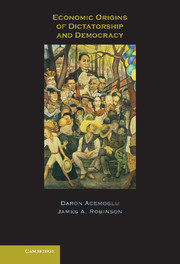Book contents
- Frontmatter
- Contents
- Preface
- PART ONE QUESTIONS AND ANSWERS
- PART TWO MODELING POLITICS
- PART THREE THE CREATION AND CONSOLIDATION OF DEMOCRACY
- PART FOUR PUTTING THE MODELS TO WORK
- 8 The Role of the Middle Class
- 9 Economic Structure and Democracy
- 10 Globalization and Democracy
- PART FIVE CONCLUSIONS AND THE FUTURE OF DEMOCRACY
- PART SIX APPENDIX
- Bibliography
- Index
9 - Economic Structure and Democracy
Published online by Cambridge University Press: 05 September 2012
- Frontmatter
- Contents
- Preface
- PART ONE QUESTIONS AND ANSWERS
- PART TWO MODELING POLITICS
- PART THREE THE CREATION AND CONSOLIDATION OF DEMOCRACY
- PART FOUR PUTTING THE MODELS TO WORK
- 8 The Role of the Middle Class
- 9 Economic Structure and Democracy
- 10 Globalization and Democracy
- PART FIVE CONCLUSIONS AND THE FUTURE OF DEMOCRACY
- PART SIX APPENDIX
- Bibliography
- Index
Summary
Introduction
So far, we have taken the determination of the level and distribution of income as exogenous. In this chapter, we endogenize the level and distribution of income. Instead of being directly endowed with income, people have various endowments of assets: land, labor, and physical and human capital. We introduce a technology, an aggregate production function, that determines how these factors of production can be combined to produce output. We also introduce key economic institutions, specifically property rights and competitive markets, that determine the rates of return on various assets.
Why would any of this matter? Intuitively, the structure of the economy or economic institutions could be important if they influence the trade-off between democracy and nondemocracy for the elites or the benefits of democracy as opposed to revolution for the citizens. There are many reasons why this might be so. First, the structure of the economy might influence the costs of revolution, repression, or coups. Second, the structure of the economy may also influence the nature of redistributive politics between different groups, something that our framework links to the creation and consolidation of democracy. We investigate both sets of ideas in this chapter. The models analyzed also allow us to consider some of the most salient claims in the political science and sociology literature about democracy.
- Type
- Chapter
- Information
- Economic Origins of Dictatorship and Democracy , pp. 287 - 320Publisher: Cambridge University PressPrint publication year: 2005



